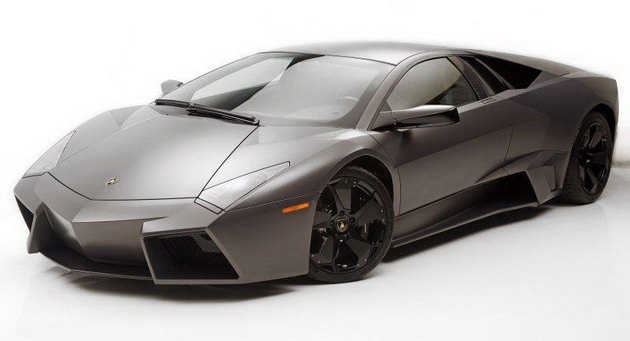Each year the LA Auto Show plays host to the Los Angeles Design Challenge, where aspiring designers partner with automakers to envision the future of mobility. This year's theme was to create the 1,000-pound car, and Mercedes-Benz' three designs – one from the U.S., another from Germany and yet another from Japan – are predictably out there.
The entrant from Mercedes' U.S. design arm in Carlsbad, CA was not only rendered but built into a full-scale model. The basis for the Biome Concept is a vehicle that "grows in a completely organic environment from seeds sown in a nursery." Not only that, but it's powered by a combination of the sun and a chemical bond from an imaginary liquid dubbed BioNectar4534. It's all natural, all organic and all science fiction. Size-wise, the Biome comes in at a theoretical 875 pounds, but it's massively wide, slightly shorter than a CL and about as tall as a Vector.
M-B's German design team created the Smart Weight-Watch, an ultra-compact dunebuggy with removable and recyclable plastic and cloth panels, a carbon fiber tub and tires (you read that last part right) and a lithium-ion battery powering two 15 kW motors. Total weight: exactly 1,000 pounds.
Finally there's the Maybach eRikscha from Japan, a four-passenger, two-wheeled "amalgamation of organic intelligence and biomechanical engineering artistry." Ummm... sure.
You can bone up on all three concepts in the press release after the jump and check out live images and design sketches below.
Get ready to have your concept of how a car is manufactured flipped upside-down and turned inside-out. Picture a production process that has plenty in common with agar jelly (used to culture organic materials in laboratories) and little in common with what we would normally think of as production-line automotive manufacturing. You are starting to get close to what the people at Mercedes-Benz have spawned with the BIOME – one of the most outlandish and ambitious concepts in this year's Los Angeles Design Challenge.
In short, the BIOME would be grown in a lab rather than built on a production line.
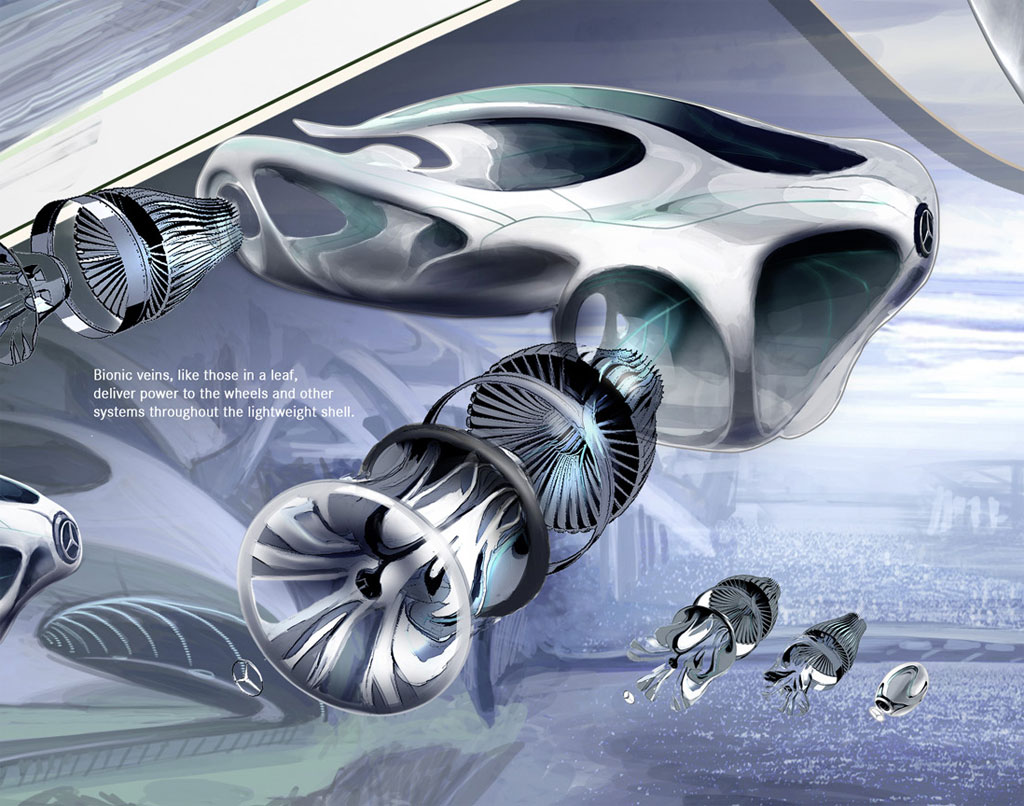
"As the inventor of the motor car, we wanted to illustrate the vision of the perfect vehicle of the future, which is created and functions in complete symbiosis with nature. The Mercedes-Benz BIOME is a natural technology hybrid, and forms part of our earth's ecosystem. It grows and thrives like the leaves on a tree" Hubert Lee, head of the Mercedes-Benz advanced design studios said.
This vision includes growing a material called BioFibre which would be lighter than metal or plastic, yet stronger than steel. The resulting car would weighs in at 875.5 lbs (around 394 kg). The entire vehicle would also be completely biodegradable.

“The interior of the BIOME grows from the DNA in the Mercedes star on the front of the vehicle, while the exterior grows from the star on the rear. To accommodate specific customer requirements, the Mercedes star is genetically engineered in each case, and the vehicle grows when the genetic code is combined with the seed capsule. The wheels are grown from four separate seeds,” Mercedes-Benz explained.
Once on the road the vehicle would run on "BioNectar4534" stored in the car's BioFibre, of which the only by-product is oxygen.
Wildly ambitious? Yes. Completely implausible? Maybe. But the whole point of the Design Challenge is to think outside the square ... the BIOME certainly does that.
Press Release:
It's a product of Merc's Los Angeles design studio, and they prefer to describe it as an 'Ultralight vehicle at one with nature.' The Biome was produced as part of the Los Angeles Design Challenge, taking part alongside the 2010 LA auto show.
The Merc Biome is made from an ultralight material called BioFibre. It's an organic matter, which Mercedes claims is significantly lighter than metal or plastic, yet is supposedly more robust than steel. Testament to this is that the Biome weighs just 394kg, says Merc.
Mercedes also says that at the end of its serviceable life it can simply be composted or even used as building material. Imagine one of these doubling up as your downstairs loo.

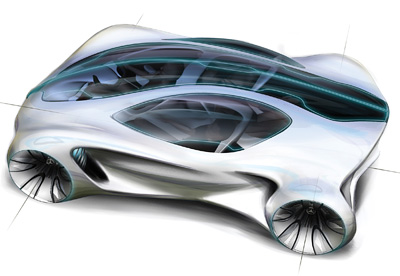
We see a great similarity to the 2005 Maserati Birdcage concept or perhaps a successor to Will Smith's Audi in iRobot. Or perhaps a new mouse design for your next Apple computer.

The entrant from Mercedes' U.S. design arm in Carlsbad, CA was not only rendered but built into a full-scale model. The basis for the Biome Concept is a vehicle that "grows in a completely organic environment from seeds sown in a nursery." Not only that, but it's powered by a combination of the sun and a chemical bond from an imaginary liquid dubbed BioNectar4534. It's all natural, all organic and all science fiction. Size-wise, the Biome comes in at a theoretical 875 pounds, but it's massively wide, slightly shorter than a CL and about as tall as a Vector.

M-B's German design team created the Smart Weight-Watch, an ultra-compact dunebuggy with removable and recyclable plastic and cloth panels, a carbon fiber tub and tires (you read that last part right) and a lithium-ion battery powering two 15 kW motors. Total weight: exactly 1,000 pounds.

Finally there's the Maybach eRikscha from Japan, a four-passenger, two-wheeled "amalgamation of organic intelligence and biomechanical engineering artistry." Ummm... sure.
You can bone up on all three concepts in the press release after the jump and check out live images and design sketches below.
Get ready to have your concept of how a car is manufactured flipped upside-down and turned inside-out. Picture a production process that has plenty in common with agar jelly (used to culture organic materials in laboratories) and little in common with what we would normally think of as production-line automotive manufacturing. You are starting to get close to what the people at Mercedes-Benz have spawned with the BIOME – one of the most outlandish and ambitious concepts in this year's Los Angeles Design Challenge.
In short, the BIOME would be grown in a lab rather than built on a production line.


"As the inventor of the motor car, we wanted to illustrate the vision of the perfect vehicle of the future, which is created and functions in complete symbiosis with nature. The Mercedes-Benz BIOME is a natural technology hybrid, and forms part of our earth's ecosystem. It grows and thrives like the leaves on a tree" Hubert Lee, head of the Mercedes-Benz advanced design studios said.
This vision includes growing a material called BioFibre which would be lighter than metal or plastic, yet stronger than steel. The resulting car would weighs in at 875.5 lbs (around 394 kg). The entire vehicle would also be completely biodegradable.

“The interior of the BIOME grows from the DNA in the Mercedes star on the front of the vehicle, while the exterior grows from the star on the rear. To accommodate specific customer requirements, the Mercedes star is genetically engineered in each case, and the vehicle grows when the genetic code is combined with the seed capsule. The wheels are grown from four separate seeds,” Mercedes-Benz explained.
Once on the road the vehicle would run on "BioNectar4534" stored in the car's BioFibre, of which the only by-product is oxygen.
Wildly ambitious? Yes. Completely implausible? Maybe. But the whole point of the Design Challenge is to think outside the square ... the BIOME certainly does that.

Press Release:
At this year's Los Angeles Design Challenge, the designers from the Mercedes-Benz Advanced Design Studios in Carlsbad, California, surprised everyone with a revolutionary vision. Taking their inspiration from nature, they designed a vehicle which is fully integrated into the ecosystem, from the moment of its creation right through to the end of its service life. The Mercedes-Benz BIOME grows in a completely organic environment from seeds sown in a nursery. Out on the road the car emits pure oxygen, and at the end of its lifespan it can be simply composted or used as building material.
"As the inventor of the motor car, we wanted to illustrate the vision of the perfect vehicle of the future, which is created and functions in complete symbiosis with nature. The Mercedes-Benz BIOME is a natural technology hybrid, and forms part of our earth's ecosystem. It grows and thrives like the leaves on a tree" according to Hubert Lee, Head of the Mercedes-Benz Advanced Design Studios in Carlsbad. This year the competition had called for the creation of a vision of a safe and comfortable 2+2 compact car featuring good handling and a first-class design, and weighing only 1,000 lbs (around 454 kg/kerb weight).
Mercedes-Benz symbiosis – a partnership with nature
The Mercedes-Benz BIOME symbiosis vehicle is made from an ultralight material called BioFibre and tips the scales at just 875.5 lbs (around 394 kg). This material is significantly lighter than metal or plastic, yet more robust than steel. BioFibre is grown from proprietary DNA in the Mercedes-Benz nursery, where it collects energy from the sun and stores it in a liquid chemical bond called BioNectar4534. As part of this process, the vehicle is created from two seeds: The interior of the BIOME grows from the DNA in the Mercedes star on the front of the vehicle, while the exterior grows from the star on the rear. To accommodate specific customer requirements, the Mercedes star is genetically engineered in each case, and the vehicle "grows" when the genetic code is combined with the seed capsule. The wheels are grown from four separate seeds.
The Mercedes-Benz BIOME is powered by BioNectar4534, which is stored in the BioFibre material of the chassis, interior, and wheels. In addition, Mercedes-Benz has developed a technology to equip trees with special receptors which can collect the excess solar energy and turn it into BioNectar4534. This creates a direct link with nature's energy sources and acts as an incentive to cover mobility energy requirements through more trees and at the same time maintain natural resources. Like plants, the Mercedes-Benz symbiosis vehicle also produces oxygen, thereby contributing to improving air quality. At the end of its service life, the Mercedes-Benz BIOME can be fully composted or used as building material. Thanks to the exclusive use of green technologies, the BIOME vehicle thus blends seamlessly into the ecosystem.
The "Knitted" smart 454 – Weight Watch Technologies from Germany
Stuttgart/Los Angeles – American West Coast zest for life meets German technology, design art, and granny's hand-knitted woollen socks. The designers at the Mercedes-Benz Advanced Design Studio in Sindelfingen based their design for an unusual smart with four seats for this year's Los Angeles Design Challenge on these principles. The smart 454 is produced by "Smart Granny Robots" (SGR) using weight watch technologies (WWT). These incredible high-tech robots are equipped with huge knitting needles. Like our grandmothers used to knit, they knit the smart's tridion cell from carbon fibres. This knitting creates complex shapes and structures which enable the vehicle geometry to be optimised in terms of weight and strength. When empty, the visionary small car weighs in at just 454 kilogrammes.
For the Los Angeles Design Challenge international car design studios were invited to design a visionary car weighing 1,000 American pounds (approx. 454 kilogrammes). The four-seater small car had to be safe and comfortable, offer good handling performance and first-class design. Steffen Köhl, Head of Mercedes-Benz Advanced Design says: "As the prototype of the lightweight and environmentally friendly city car smart is predestined for this challenge. It met all the basic requirements. We just had to further optimise the lightweight construction coupled with a distinctive and individual design."
Lightweight design with different materials for an individual look
Every single component of the smart 454 is made of different materials to give it characteristic features and a specific look. Every part is manufactured with the precise materials necessary for a perfect balance between weight and function. The windows, fenders, and bumpers are made of recyclable, coloured plastic. The roof is made of thin yet highly durable recycled textile fabric in various printed and woven patterns. The WWT carbon fibre tyres with integrated suspension have an extremely lightweight design and rule out the risk of a flat tyre. The unique SGR technology is the best lightweight design technology for rims and enables truly unique rims to be produced.
The smart 454 is driven by two 15 kW electric motors which are powered by a replaceable lithium-ion battery. The motors are housed between the rear wheels. In the interior the city runabout does not need an instrument panel at all. All functions are controlled and managed via an iPad, for example speedometer and battery charge indicator, navigation system, or air conditioning.
The modular "clip-on" design principle familiar from smart enables a sheer endless spectrum of customer wishes to be easily realised. Doors, roof, engine, and transmission are simple to exchange – for an individual look and driving fun and the best possible vehicle configuration for every occasion.
The Maybach eRikscha – The Luxury Model for Tomorrow's Urban Mobility
Maybach unveils its draft for an electrically driven luxury rickshaw at the Los Angeles Design Challenge
Maybach DRS – "Den-Riki-Sha" – combining ultralight design with a uniquely luxurious exterior and interior
The world's first naturally manufactured luxury vehicle
Stuttgart/Los Angeles. As it presents its draft design for an electrically powered luxury rickshaw, Stuttgart's Maybach Manufaktur automotive hand-finishing section is exploring radical new avenues for the urban mobility of tomorrow as part of the Los Angeles Design Challenge. The Maybach DRS – "Den-Riki-Sha" (= electrically driven rickshaw) – blends the very latest automotive technology, luxurious comfort, and the highest safety levels with the needs of an environmentally aware world and the traditional values of the classic "Jin-Riki-Sha" (human-powered rickshaw). The futuristic four-seater is created through metamorphosis from a DNA cocoon, making it the world's first naturally manufactured vehicle. The rickshaw was developed by the designers at the Mercedes-Benz Advanced Design Studios in Tokyo – participating in the Los Angeles Design Challenge for the first time.
The design competition had invited international automotive design studios to draw up their vision of a car that weighs 1,000 American pounds (around 454 kilogrammes) (kerb weight). The remit was to create a four-seater small car that is safe and comfortable, offering good handling and first-class design. "This was a major challenge – in particular for a brand such as Maybach, whose luxury has thus far manifested itself not least in the vehicles' size. This is why, when building the Maybach DRS, we combined the European concept of luxury with the Asian feel for optimum use of space, so we were able to create a vehicle which blends both in an intelligent manner. Thereby we have shortly undermatched the weight limit", explained Holger Hutzenlaub, who heads the Mercedes-Benz Advanced Design Studios in Tokyo.
The amalgamation of organic intelligence and biomechanical engineering artistry
Breathtaking looks, polished luxury, and technical brilliance characterise the ambitious development of the Maybach DRS. The design is reminiscent of a butterfly's cocoon, light and elegant as it floats between two oversized wheels. The rickshaw is made in a unique, natural production process. Through a complex and perfect metamorphosis a finished vehicle is developed from a DNA cocoon: Organic intelligence blends with advanced biomechanical engineering. The result is a futuristic combination of an ultralight structure and an unparalleled luxury exterior and interior – for a limited number of exclusive vehicles.
The vehicle frame consists of carbon fibres and organic composite materials, whilst the doors and windows are made of injection-moulded polycarbonate and the panoramic roof of flexible organic composite materials. The Maybach DRS is powered by two 20 kW electric motors which are positioned in the wheel hubs and are self-balancing. The energy required is produced by a lithium-ion battery in the tail end. An on-board computer ensures optimum control, communicating with the metropolis's transport infrastructure, and thus guaranteeing a smooth, luxurious ride through the city. In order to increase the vehicle's range, the human/electric hybrid also allows additional pedal force, which is produced by the driver.
Totally true to the grand Maybach tradition of luxurious mobility, the Maybach DRS – "Den-Riki-Sha" – is carrying forward this heritage, paying homage to the roads of tomorrow.
Los Angeles Design Challenge
The Los Angeles Design Challenge is part of the Design Los Angeles conference, taking place from 17 to 18 November 2010 as part of the Los Angeles Auto Show. The winner of the competition will be announced on 18 November 2010.
Now, what on earth, or for that matter not from earth have we got here? It's the Mercedes Biome concept supercar."As the inventor of the motor car, we wanted to illustrate the vision of the perfect vehicle of the future, which is created and functions in complete symbiosis with nature. The Mercedes-Benz BIOME is a natural technology hybrid, and forms part of our earth's ecosystem. It grows and thrives like the leaves on a tree" according to Hubert Lee, Head of the Mercedes-Benz Advanced Design Studios in Carlsbad. This year the competition had called for the creation of a vision of a safe and comfortable 2+2 compact car featuring good handling and a first-class design, and weighing only 1,000 lbs (around 454 kg/kerb weight).
Mercedes-Benz symbiosis – a partnership with nature
The Mercedes-Benz BIOME symbiosis vehicle is made from an ultralight material called BioFibre and tips the scales at just 875.5 lbs (around 394 kg). This material is significantly lighter than metal or plastic, yet more robust than steel. BioFibre is grown from proprietary DNA in the Mercedes-Benz nursery, where it collects energy from the sun and stores it in a liquid chemical bond called BioNectar4534. As part of this process, the vehicle is created from two seeds: The interior of the BIOME grows from the DNA in the Mercedes star on the front of the vehicle, while the exterior grows from the star on the rear. To accommodate specific customer requirements, the Mercedes star is genetically engineered in each case, and the vehicle "grows" when the genetic code is combined with the seed capsule. The wheels are grown from four separate seeds.
The Mercedes-Benz BIOME is powered by BioNectar4534, which is stored in the BioFibre material of the chassis, interior, and wheels. In addition, Mercedes-Benz has developed a technology to equip trees with special receptors which can collect the excess solar energy and turn it into BioNectar4534. This creates a direct link with nature's energy sources and acts as an incentive to cover mobility energy requirements through more trees and at the same time maintain natural resources. Like plants, the Mercedes-Benz symbiosis vehicle also produces oxygen, thereby contributing to improving air quality. At the end of its service life, the Mercedes-Benz BIOME can be fully composted or used as building material. Thanks to the exclusive use of green technologies, the BIOME vehicle thus blends seamlessly into the ecosystem.
The "Knitted" smart 454 – Weight Watch Technologies from Germany
Stuttgart/Los Angeles – American West Coast zest for life meets German technology, design art, and granny's hand-knitted woollen socks. The designers at the Mercedes-Benz Advanced Design Studio in Sindelfingen based their design for an unusual smart with four seats for this year's Los Angeles Design Challenge on these principles. The smart 454 is produced by "Smart Granny Robots" (SGR) using weight watch technologies (WWT). These incredible high-tech robots are equipped with huge knitting needles. Like our grandmothers used to knit, they knit the smart's tridion cell from carbon fibres. This knitting creates complex shapes and structures which enable the vehicle geometry to be optimised in terms of weight and strength. When empty, the visionary small car weighs in at just 454 kilogrammes.
For the Los Angeles Design Challenge international car design studios were invited to design a visionary car weighing 1,000 American pounds (approx. 454 kilogrammes). The four-seater small car had to be safe and comfortable, offer good handling performance and first-class design. Steffen Köhl, Head of Mercedes-Benz Advanced Design says: "As the prototype of the lightweight and environmentally friendly city car smart is predestined for this challenge. It met all the basic requirements. We just had to further optimise the lightweight construction coupled with a distinctive and individual design."
Lightweight design with different materials for an individual look
Every single component of the smart 454 is made of different materials to give it characteristic features and a specific look. Every part is manufactured with the precise materials necessary for a perfect balance between weight and function. The windows, fenders, and bumpers are made of recyclable, coloured plastic. The roof is made of thin yet highly durable recycled textile fabric in various printed and woven patterns. The WWT carbon fibre tyres with integrated suspension have an extremely lightweight design and rule out the risk of a flat tyre. The unique SGR technology is the best lightweight design technology for rims and enables truly unique rims to be produced.
The smart 454 is driven by two 15 kW electric motors which are powered by a replaceable lithium-ion battery. The motors are housed between the rear wheels. In the interior the city runabout does not need an instrument panel at all. All functions are controlled and managed via an iPad, for example speedometer and battery charge indicator, navigation system, or air conditioning.
The modular "clip-on" design principle familiar from smart enables a sheer endless spectrum of customer wishes to be easily realised. Doors, roof, engine, and transmission are simple to exchange – for an individual look and driving fun and the best possible vehicle configuration for every occasion.
The Maybach eRikscha – The Luxury Model for Tomorrow's Urban Mobility
Maybach unveils its draft for an electrically driven luxury rickshaw at the Los Angeles Design Challenge
Maybach DRS – "Den-Riki-Sha" – combining ultralight design with a uniquely luxurious exterior and interior
The world's first naturally manufactured luxury vehicle
Stuttgart/Los Angeles. As it presents its draft design for an electrically powered luxury rickshaw, Stuttgart's Maybach Manufaktur automotive hand-finishing section is exploring radical new avenues for the urban mobility of tomorrow as part of the Los Angeles Design Challenge. The Maybach DRS – "Den-Riki-Sha" (= electrically driven rickshaw) – blends the very latest automotive technology, luxurious comfort, and the highest safety levels with the needs of an environmentally aware world and the traditional values of the classic "Jin-Riki-Sha" (human-powered rickshaw). The futuristic four-seater is created through metamorphosis from a DNA cocoon, making it the world's first naturally manufactured vehicle. The rickshaw was developed by the designers at the Mercedes-Benz Advanced Design Studios in Tokyo – participating in the Los Angeles Design Challenge for the first time.
The design competition had invited international automotive design studios to draw up their vision of a car that weighs 1,000 American pounds (around 454 kilogrammes) (kerb weight). The remit was to create a four-seater small car that is safe and comfortable, offering good handling and first-class design. "This was a major challenge – in particular for a brand such as Maybach, whose luxury has thus far manifested itself not least in the vehicles' size. This is why, when building the Maybach DRS, we combined the European concept of luxury with the Asian feel for optimum use of space, so we were able to create a vehicle which blends both in an intelligent manner. Thereby we have shortly undermatched the weight limit", explained Holger Hutzenlaub, who heads the Mercedes-Benz Advanced Design Studios in Tokyo.
The amalgamation of organic intelligence and biomechanical engineering artistry
Breathtaking looks, polished luxury, and technical brilliance characterise the ambitious development of the Maybach DRS. The design is reminiscent of a butterfly's cocoon, light and elegant as it floats between two oversized wheels. The rickshaw is made in a unique, natural production process. Through a complex and perfect metamorphosis a finished vehicle is developed from a DNA cocoon: Organic intelligence blends with advanced biomechanical engineering. The result is a futuristic combination of an ultralight structure and an unparalleled luxury exterior and interior – for a limited number of exclusive vehicles.
The vehicle frame consists of carbon fibres and organic composite materials, whilst the doors and windows are made of injection-moulded polycarbonate and the panoramic roof of flexible organic composite materials. The Maybach DRS is powered by two 20 kW electric motors which are positioned in the wheel hubs and are self-balancing. The energy required is produced by a lithium-ion battery in the tail end. An on-board computer ensures optimum control, communicating with the metropolis's transport infrastructure, and thus guaranteeing a smooth, luxurious ride through the city. In order to increase the vehicle's range, the human/electric hybrid also allows additional pedal force, which is produced by the driver.
Totally true to the grand Maybach tradition of luxurious mobility, the Maybach DRS – "Den-Riki-Sha" – is carrying forward this heritage, paying homage to the roads of tomorrow.
Los Angeles Design Challenge
The Los Angeles Design Challenge is part of the Design Los Angeles conference, taking place from 17 to 18 November 2010 as part of the Los Angeles Auto Show. The winner of the competition will be announced on 18 November 2010.
It's a product of Merc's Los Angeles design studio, and they prefer to describe it as an 'Ultralight vehicle at one with nature.' The Biome was produced as part of the Los Angeles Design Challenge, taking part alongside the 2010 LA auto show.
Tell me more about the Mercedes Biome concept car...
In a nutshell, the concept is designed to integrate fully in to the ecosystem from 'dust to dust.' So they've concentrated on cleaning up the Biome's act, during production, over its lifespan, and at the time of its eventual disposal or recycling.The Merc Biome is made from an ultralight material called BioFibre. It's an organic matter, which Mercedes claims is significantly lighter than metal or plastic, yet is supposedly more robust than steel. Testament to this is that the Biome weighs just 394kg, says Merc.
Mercedes also says that at the end of its serviceable life it can simply be composted or even used as building material. Imagine one of these doubling up as your downstairs loo.

What does the Biome run on then, moon-juice?
It is powered by a strain of biofuel called BioNectar4534, which the car stores in the BioFibre material of the chassis, interior and wheels. Mercedes claims the fuel emits nothing but pure oxygen. Which sounds completely at odds with conventional biofuels and the combustion process.
So, what to make of the Biome's design?
A little bit of a departure from the E240 CDI taxi that ferries you home on a Friday night, that's for sure.We see a great similarity to the 2005 Maserati Birdcage concept or perhaps a successor to Will Smith's Audi in iRobot. Or perhaps a new mouse design for your next Apple computer.

When can we expect to see the Mercedes Biome in our nearest showroom?
While the technology and research in the Biome is fascinating, we don't really need to tell you that nothing like this will seen in the near future. Do we?
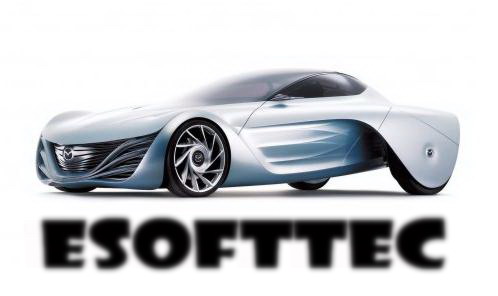




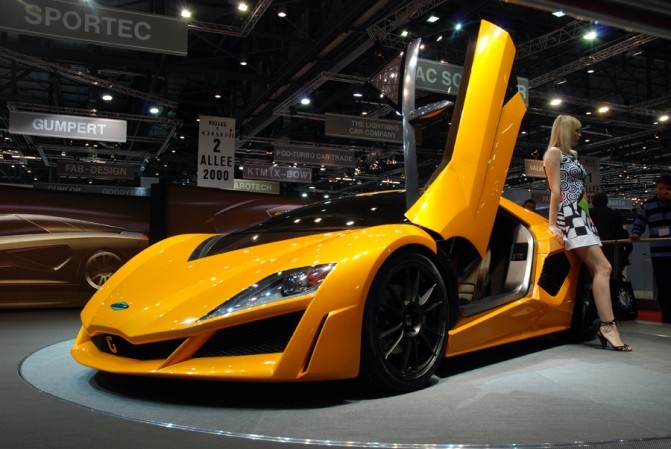


 It is described as a "concept for a $230,000 four-door sedan".It currently houses a 5.2 litre V10 engine, although there has been speculation that this could be replaced by a V12, V8, or possibly even a hybrid or turbo-diesel engine, as suggested by Lamborghini's Brand Director, Manfred Fitzgerald.
It is described as a "concept for a $230,000 four-door sedan".It currently houses a 5.2 litre V10 engine, although there has been speculation that this could be replaced by a V12, V8, or possibly even a hybrid or turbo-diesel engine, as suggested by Lamborghini's Brand Director, Manfred Fitzgerald.



















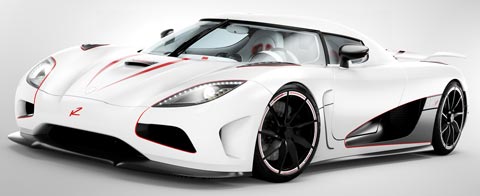
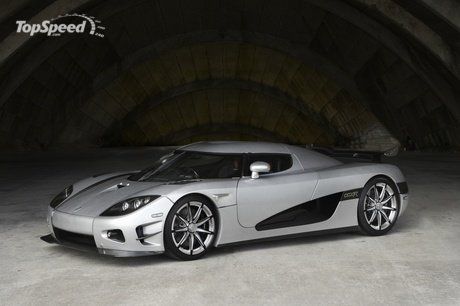




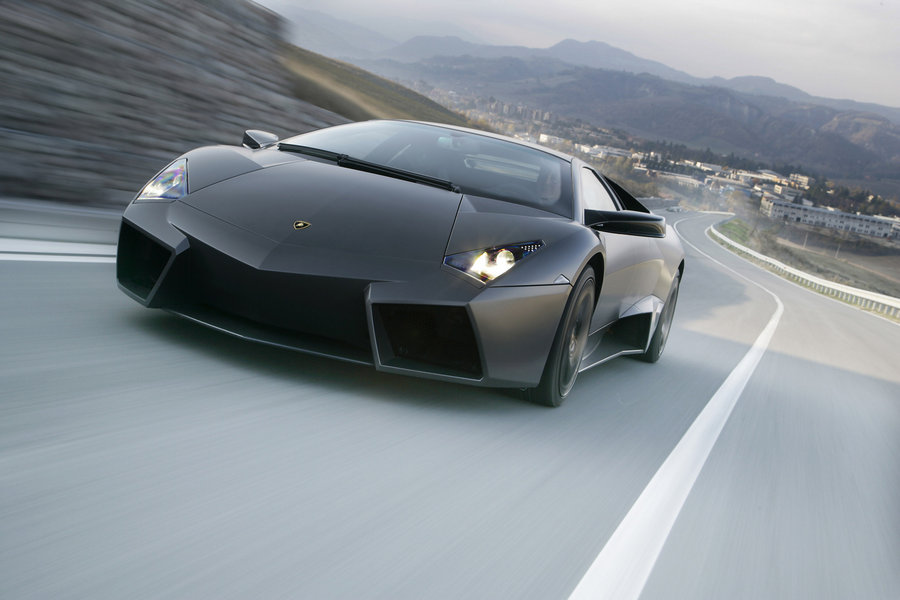
 .
.
